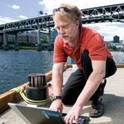
- Columbia River
Estuarine turbidity maxima (ETM) retain suspended particulate matter (SPM) through advection, settling, aggregation and non-linearities in bed processes. This contribution defines for the first time a parameter space descriptive of ETM water-column particle trapping processes through a scaling analysis of the local and integral SPM balances. In the absence of long-term deposition, there are five primary parameters for the large particles or aggregates that are typically trapped. Rouse number P, the ratio of settling velocity WS of the SPM relative to the shear velocity U*, describes the material trapped in the ETM in terms of the local vertical balance between vertical mixing and aggregate settling. Advection number A= P ΔU/UT scales the landward transport of SPM by tidal and mean flow processes in terms of flood-ebb velocity difference (ΔU) and maximum tidal current (UT). Supply number SR = P UR/UT defines SPM supply and removal (UR is river flow). Changes in the estuarine inventory of SPM are described in terms of a Trapping Efficiency E, a ratio of peak ETM concentration to fluvial or marine supply concentration. The effects of aggregation in the integral dynamic balance are quantified by a Floc number F that describes the tendency of aggregates to form through shear-driven collisions. This study uses observations from two strongly advective systems (the Columbia and Fraser Rivers) plus literature values from 13 other estuaries to illustrate the applicability of the above scaling. The primary question investigated is the relationship of trapping efficiency E and Floc number F to other parameters, especially river flow (expressed in terms of supply number SR). The strongest SPM trapping (high E) occurs in mid-ETM, where A ~0. The extreme high flows observed in the Fraser River estuary show how ETM trapping becomes ineffective as the estuary length contracts to one tidal excursion or less (limit of high SR). Use of data from all 15 estuaries shows that there is a strong trend toward more efficient trapping for low SR. E and F are positively correlated, so that aggregation becomes more prominent in systems with weak to moderate river flow. Examination of tidal monthly and seasonal particle properties at four closely-spaced moorings in the Columbia emphasize the importance of strong ETM gradients – particle properties are diverse even when the hydrodynamic regime is apparently similar. Finally, scaling variables and data are combined to express ETM properties in terms of U*, UR and UT..
Available at: http://works.bepress.com/david_jay/46/

This is the author's version of a work that was submitted to Continental Shelf Research.